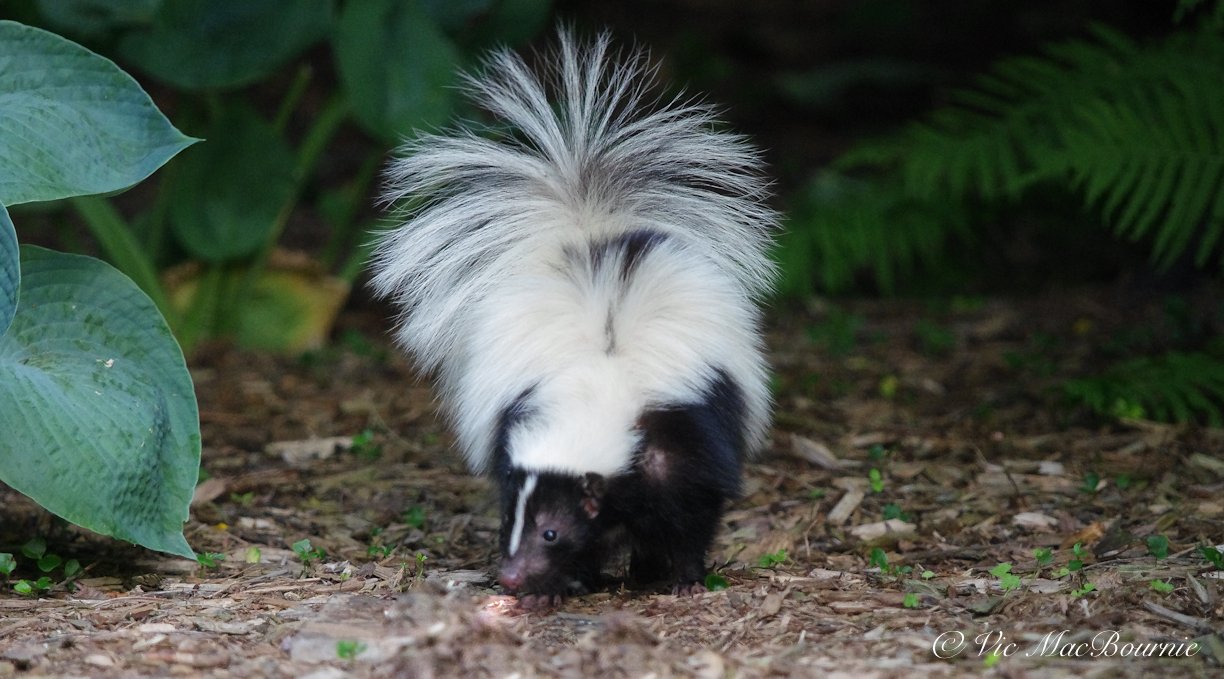Why do I smell skunks in mid February?
Why are we seeing and smelling skunks in the middle of February?
The ground is covered with two feet of snow and skunks seem to be everywhere – we see them roaming through the back and front gardens and smell them on a nightly basis.
What gives?
Turns out female skunks are down right stinkers when it comes to fending off amorous male skunks looking to mate, and all this takes place in mid February right around the time of Valentine’s Day.
That explains the nightly smells we get sitting in our family room – not enough to suggest a full-fledged unleashing of the musky odour experienced when one of our striped friends unleashes on an excitable canine – but enough to get your attention. Especially if it’s right outside the door.
A skunk looking for food in the early evening in the garden. I was out hoping to get a photograph of a fox and the skunk showed up instead with its beautiful tail.
The mating season brings out more of these solitary, elusive animals as they look for partners to begin families. It’s a time when male skunks are more active asserting dominance over other males, while females skunks, who are either not ready to mate or choose not to with a particular male, use their musk glands to fend of advances. These encounters cause both the males and females to spread small amounts of musk – just enough to make us take notice.
You may also be getting a slight odour from under your shed or deck where they are living. Be sure to give them plenty of space and move slowly around them, but they are harmless and very beneficial so it’s much better to learn to live with them than have them removed.
This mid-February odour is not near as strong as you will experience when skunks are killed along the road or when they use it in self defence after being frightened by a neighbourhood dog.
Be prepared for a skunk spray. Check out my post on what to do if your dog or family member has been sprayed by a skunk.
What are skunks’ breeding habits?
Female striped skunks give birth to kits in early spring around April and May after mating in and around mid February. Females can breed in their second summer and give birth to as many as four to seven babies. Older females can come into estrus earlier than younger female skunks and may have litters earlier in spring. Following a sixty-day gestation period, the kits are born in shallow dens or, more likely, under sheds or decks in our yards.
Born blind and deaf and sporting short, fine fur, babies are nursed in the den for about six weeks before venturing out of the den for short excursions with mom. The young skunks are usually weaned from their mother by two months of age.
By fall, the family members have gone their separate ways, travelling as far as 50 kms but usually no more than 5-10 kms, looking for new territory.
Skunks and Great Horned Owls: A deadly combination
We’ve lived in our current home for almost 25 years and have only experienced skunks in the past few years. Where did these skunks come from?
Although we live in a heavily forested area surrounded by conservation lands where you would expect to be living with skunks, up until recently they were nowhere to be seen. I firmly believe that the reason we are experiencing more skunks in our neighbourhood is the result of a severe decline of the Great Horned Owl – skunks’ greatest natural predator.
Typical neighbourhoods offer a cornucopia of food for these shy, inquisitive animals in the form of unprotected garbage cans and pet food left out on decks and back patios. Acres of manicured grass provide skunks with an abundance of grubs, other insects and even mice, just to name a few.
Coyotes, foxes and other predators know enough not to tangle with skunks and will not prey on them unless they are desperate, but Great Horned Owls’ lack of smell allows them to prey on skunks.
This makes the Great horned Owl the primary predator of striped skunks. Although skunks can weigh up to three times more than a typical Great Horned Owl, the deadly talons of the owls make them efficient killers of skunks, whose only real defence is their ability to spray the strong sulphur musk. The owls’ huge, deadly talons combined with their ability to squeeze up to 500 pounds per square inch, means this crushing grip will often kill larger prey like skunks instantly.
The fact that skunks like to travel at night, just when the Great Horned Owls are on the prowl, makes them easy prey. In fact, it is reported that one owl nest contained the remains of nearly 60 skunks.
With an average life span in the wild of between 5-15 years, a Great Horned Owl can certainly do its part in keeping neighbourhoods free of skunks.
That’s good a good reason to do all you can to encourage Great Horned Owls to your neighbourhood. The best way to accomplish this is not to cut down dead trees, especially those that are large enough to provide habitat for these large owls. See my earlier article on the importance of leaving snags in your garden.


